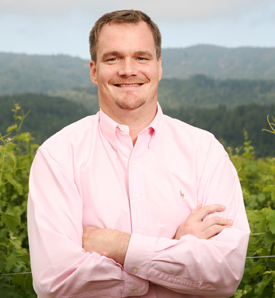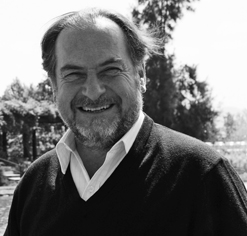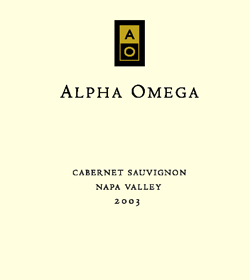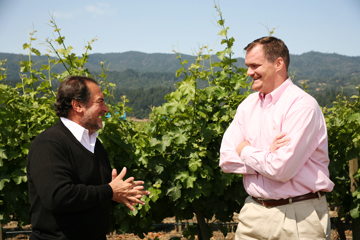

Winemaker at one of Napa Valley's newest wineries, Alpha Omega, Jean Hoefliger likes to keep everything as natural as possible.
Rutherford ~ Napa Valley (AVA)
When Mr. Natural Meets Dr. Blender
You are at Alpha Omega
An interview with Alpha Omega Winery's JEAN HOEFLIGER reveals what happens when master blender Michel Rolland consults.
by
Alan Goldfarb
August 27, 2007
ALAN GOLDFARB (AG): Rolland seems to have the polar opposite philosophy from yours. How do you work together?
JEAN HOEFLIGER (JH): We benefit from each other. I look for someone who is going to doubt me. That’s how we’re going to maximize the potential of the wine. … He has a global view that I don’t buy, being here. When it gets to the wine, he says, “you make the wine.” We sit and blend together.
AG: How much manipulation do you do? Do you use de-alcoholization (to lower the alcohol level) or microoxygenation (which speeds up the process by eliminating some oak barrels). Rolland is purported to be a proponent of this technique?
JH: I naturally ferment, and I don’t fine and filter. The reds are (partially) in barrel and tanks in order to have more complexity. For him (Rolland), it seems to be the right proportion. And I never put my wines through MOX (microoxygenation). I don’t believe in that. I’m a quite natural thinker. All I try to do is make sure nature doesn’t go the wrong way. I try to maximize the potential of nature and what it gives me.
AG: Does Rolland disagree?
JH: Yes. (But) I taste every single day, so there’s less room for mistakes. Fining is readjusting, but if you taste your wines every day (there’s no need). I never intrude on the wine’s personality. I want to respect the wine as if it’s a human being. I don’t want to be reaching in. I don’t rack (move the fermenting wine from tank or barrel to barrel in order to settle the sediment), often because it’s quite violent.

Even pictured in black and white there’s no denying Michel Rolland makes colorful wine. Rolland cannot erase the wine already made. He can maximize what we have. But I make the wine and I make the decisions all year long. … I will not allow it. “I cannot (change the wine),” he told me, “you make the wine.”
I asked him five years before the movie (“Mondovino”) came out, “Don’t you think you and Robert Parker make wine more uniform throughout the world?” He said, “That’s a gusty move (question).” He said, “I cannot (make wine uniform); I don’t have the power to.”
He has a principle of doing things but it’s the winemaker, terroir and the limits that give birth to these (wines). He has to live with and blend the army (the various components) that he is working with. The reason I’m still working with him is that I’ve proven myself.
AG: Rolland, I believe, likes big wines. At what alcohol levels, do your wines finish?
JH: At 14.5 to 15.3 percent. That’s the biggest challenge today. People have moved way too far in ripeness. That’s why we have deaclcoholization. In order to find that balance, you need to find an earlier ripeness. If you manage it in the right way, you can make balanced wines.
AG: At what Brix (sugar) levels to you usually pick?
JH: Last year it was 24.5 to 27.5 percent. … I’m against making over-extracted Cabernet.
AG: I know you source grapes from many different vineyards in various sub-regions of the Napa Valley. Do you then blend them? And if so, doesn’t that mitigate the terroir from each of those areas?
JH: Every single appellation that we have is going to have its own personality. But society is richer with diversity. When we see that (diversity in the wines), I like to blend them. It’s partly true that you limit terroir (by blending), but if you make a Bordeaux blend, for example, the idea is to maximize the quality of the wine. You’re going to add personality and complexity. If you’re going to make single-vineyard wines, it has to be a special year. Yes, it benefits a little bit to blend. Here (the Napa Valley) everything is made for diversity but in Bordeaux, you’re limited. It’s like giving Picasso half the color he needs.
AG: I find it intriguing that you are growing Sauvignon Blanc (and currently producing less than 500 cases) on your property, and plan to graft over the small amount of Malbec and Merlot to SB, when all around you in Rutherford, Cabernet Sauvignon is king. [Note: Less than 6 percent of planted acreage in Rutherford is to SB.]. Why do that?
JH: We have a very special property (for SB). It’s variation of height is only one foot, so its really flat. We have a super high clay content. When winter comes, the (rain)water sits in the vineyard. That’s why I’m going to do dry farming. The clay allows the roots to keep their moisture; it’s the natural AC (air conditioning) of the vine. To have that moisture is like us having our feet in an ice bucket, it keeps the vines moist. It’s hard to dry out clay, it’s like a sponge.
And it’s one of the reasons Sauvignon Blanc does so well. It’s indigenous to our property to have perfectly flat land and have clay. The challenge in Rutherford in creating a good Sauvignon Blanc is to manage and keep the heat from hurting the grapes and to ensure the integrity of the fruit.
AG: In addition to the estate, your get your fruit from Spring Mountain, Oakville, Yountville, Atlas Peak, Carneros. and Jamieson Canyon. Tell me about those other vineyards.
JH: From Spring Mountain, we get Cabernet Sauvignon, Merlot, and Petit Verdot from Newton. Spring Mountain has a different type of terroir. The Petit Verdot is sourced from rocky soil. It’s my favorite in Napa. It represents and suits Napa’s climate very well. In poor soil sources, all the character and charisma is behind that varietal.
AG: Charisma and character?
JH: It’s more like Superman. It has more tannins, more structure, more fruit than any other we use. If you struggle in life, that’s when you build your character.
AG: In Oakville, you get Cabernet Sauvignon, Merlot, Cabernet Franc, and Petit Verdot.
JH: We use Eric Sklar’s family vineyard on the Silverado Trail. It was planted originally to Merlot in the heart of the Napa Valley. He budded it over to Cab because it’s too warm.
 We also get Cab and Cab Franc from Beckstoffer’s To Kalon. It’s the heart of the valley. It’s a terorir that is so deep and so profund on very old vines (with) a perfect root system that goes through so many layers that expresses the terroir extraction. That terroir translates in the wine with multiple layers. … It gives the wine body and continuity. It’s going to stimulate you, not only in taste, but your brain with everything added together in one wine.
We also get Cab and Cab Franc from Beckstoffer’s To Kalon. It’s the heart of the valley. It’s a terorir that is so deep and so profund on very old vines (with) a perfect root system that goes through so many layers that expresses the terroir extraction. That terroir translates in the wine with multiple layers. … It gives the wine body and continuity. It’s going to stimulate you, not only in taste, but your brain with everything added together in one wine.
I compare it to meeting somebody for din
JEAN HOEFLIGER (JH): We benefit from each other. I look for someone who is going to doubt me. That’s how we’re going to maximize the potential of the wine. … He has a global view that I don’t buy, being here. When it gets to the wine, he says, “you make the wine.” We sit and blend together.
AG: How much manipulation do you do? Do you use de-alcoholization (to lower the alcohol level) or microoxygenation (which speeds up the process by eliminating some oak barrels). Rolland is purported to be a proponent of this technique?
JH: I naturally ferment, and I don’t fine and filter. The reds are (partially) in barrel and tanks in order to have more complexity. For him (Rolland), it seems to be the right proportion. And I never put my wines through MOX (microoxygenation). I don’t believe in that. I’m a quite natural thinker. All I try to do is make sure nature doesn’t go the wrong way. I try to maximize the potential of nature and what it gives me.
AG: Does Rolland disagree?
JH: Yes. (But) I taste every single day, so there’s less room for mistakes. Fining is readjusting, but if you taste your wines every day (there’s no need). I never intrude on the wine’s personality. I want to respect the wine as if it’s a human being. I don’t want to be reaching in. I don’t rack (move the fermenting wine from tank or barrel to barrel in order to settle the sediment), often because it’s quite violent.

Even pictured in black and white there’s no denying Michel Rolland makes colorful wine.
I asked him five years before the movie (“Mondovino”) came out, “Don’t you think you and Robert Parker make wine more uniform throughout the world?” He said, “That’s a gusty move (question).” He said, “I cannot (make wine uniform); I don’t have the power to.”
He has a principle of doing things but it’s the winemaker, terroir and the limits that give birth to these (wines). He has to live with and blend the army (the various components) that he is working with. The reason I’m still working with him is that I’ve proven myself.
AG: Rolland, I believe, likes big wines. At what alcohol levels, do your wines finish?
JH: At 14.5 to 15.3 percent. That’s the biggest challenge today. People have moved way too far in ripeness. That’s why we have deaclcoholization. In order to find that balance, you need to find an earlier ripeness. If you manage it in the right way, you can make balanced wines.
AG: At what Brix (sugar) levels to you usually pick?
JH: Last year it was 24.5 to 27.5 percent. … I’m against making over-extracted Cabernet.
AG: I know you source grapes from many different vineyards in various sub-regions of the Napa Valley. Do you then blend them? And if so, doesn’t that mitigate the terroir from each of those areas?
JH: Every single appellation that we have is going to have its own personality. But society is richer with diversity. When we see that (diversity in the wines), I like to blend them. It’s partly true that you limit terroir (by blending), but if you make a Bordeaux blend, for example, the idea is to maximize the quality of the wine. You’re going to add personality and complexity. If you’re going to make single-vineyard wines, it has to be a special year. Yes, it benefits a little bit to blend. Here (the Napa Valley) everything is made for diversity but in Bordeaux, you’re limited. It’s like giving Picasso half the color he needs.
AG: I find it intriguing that you are growing Sauvignon Blanc (and currently producing less than 500 cases) on your property, and plan to graft over the small amount of Malbec and Merlot to SB, when all around you in Rutherford, Cabernet Sauvignon is king. [Note: Less than 6 percent of planted acreage in Rutherford is to SB.]. Why do that?
JH: We have a very special property (for SB). It’s variation of height is only one foot, so its really flat. We have a super high clay content. When winter comes, the (rain)water sits in the vineyard. That’s why I’m going to do dry farming. The clay allows the roots to keep their moisture; it’s the natural AC (air conditioning) of the vine. To have that moisture is like us having our feet in an ice bucket, it keeps the vines moist. It’s hard to dry out clay, it’s like a sponge.
And it’s one of the reasons Sauvignon Blanc does so well. It’s indigenous to our property to have perfectly flat land and have clay. The challenge in Rutherford in creating a good Sauvignon Blanc is to manage and keep the heat from hurting the grapes and to ensure the integrity of the fruit.
AG: In addition to the estate, your get your fruit from Spring Mountain, Oakville, Yountville, Atlas Peak, Carneros. and Jamieson Canyon. Tell me about those other vineyards.
JH: From Spring Mountain, we get Cabernet Sauvignon, Merlot, and Petit Verdot from Newton. Spring Mountain has a different type of terroir. The Petit Verdot is sourced from rocky soil. It’s my favorite in Napa. It represents and suits Napa’s climate very well. In poor soil sources, all the character and charisma is behind that varietal.
AG: Charisma and character?
JH: It’s more like Superman. It has more tannins, more structure, more fruit than any other we use. If you struggle in life, that’s when you build your character.
AG: In Oakville, you get Cabernet Sauvignon, Merlot, Cabernet Franc, and Petit Verdot.
JH: We use Eric Sklar’s family vineyard on the Silverado Trail. It was planted originally to Merlot in the heart of the Napa Valley. He budded it over to Cab because it’s too warm.
 We also get Cab and Cab Franc from Beckstoffer’s To Kalon. It’s the heart of the valley. It’s a terorir that is so deep and so profund on very old vines (with) a perfect root system that goes through so many layers that expresses the terroir extraction. That terroir translates in the wine with multiple layers. … It gives the wine body and continuity. It’s going to stimulate you, not only in taste, but your brain with everything added together in one wine.
We also get Cab and Cab Franc from Beckstoffer’s To Kalon. It’s the heart of the valley. It’s a terorir that is so deep and so profund on very old vines (with) a perfect root system that goes through so many layers that expresses the terroir extraction. That terroir translates in the wine with multiple layers. … It gives the wine body and continuity. It’s going to stimulate you, not only in taste, but your brain with everything added together in one wine.
I compare it to meeting somebody for din










 t first blush, it seems highly incongruous that a California winemaker, who insists he makes wines as natural as all get out, is taking advice from a consultant that we’ll call Dr. Blender. But that’s precisely what Mr. Natural, Jean Hoefliger, is doing at one of Napa Valley’s newest wineries,
t first blush, it seems highly incongruous that a California winemaker, who insists he makes wines as natural as all get out, is taking advice from a consultant that we’ll call Dr. Blender. But that’s precisely what Mr. Natural, Jean Hoefliger, is doing at one of Napa Valley’s newest wineries, 
 READER FEEDBACK: To post your comments on this story,
READER FEEDBACK: To post your comments on this story,





